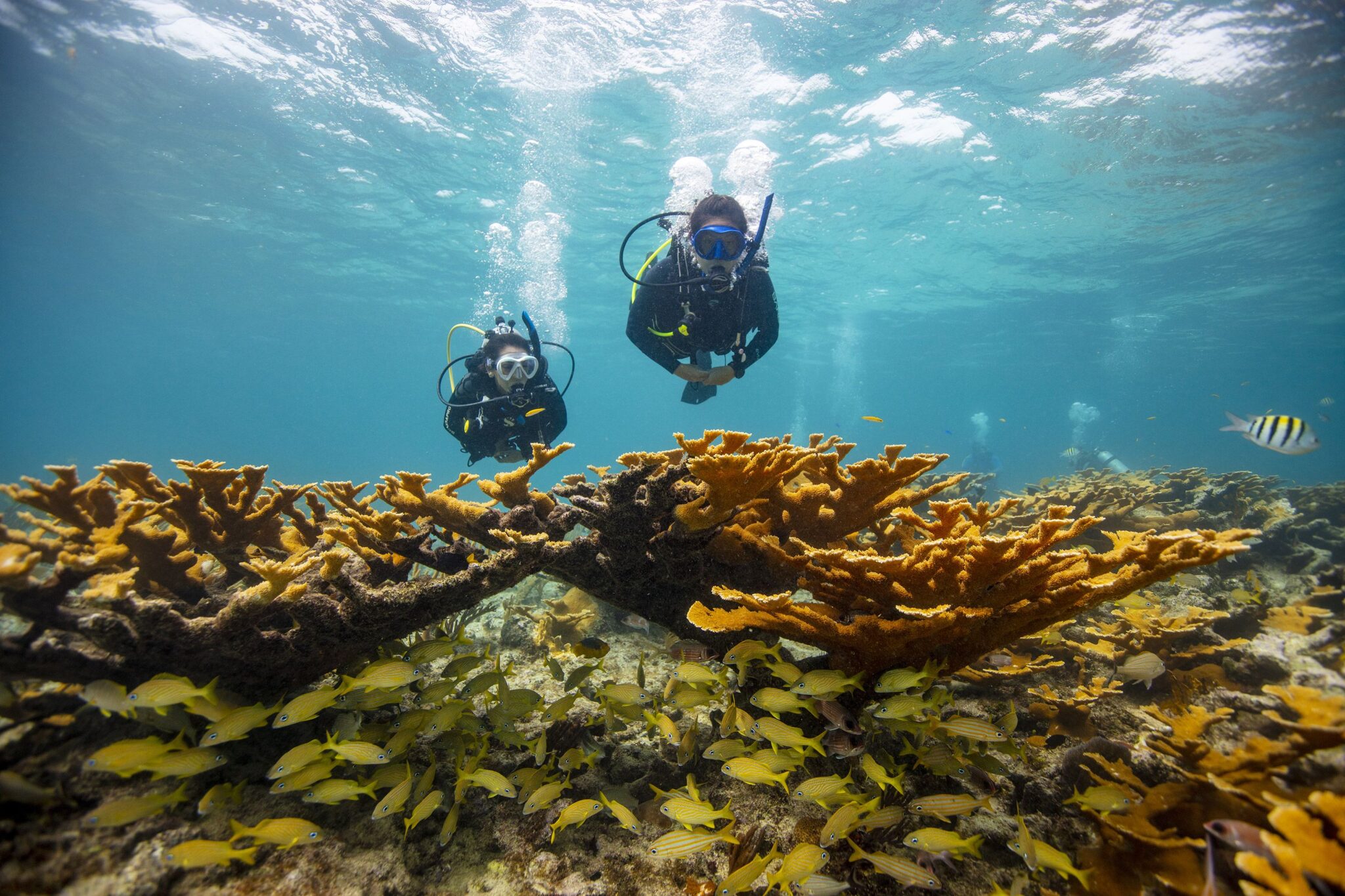So your PADI Open Water Diver course is well underway, and it’s almost time to head out to complete the open water component. But, you may be wondering, what does that entail? What are the four PADI Open Water dives? We’re going to look at what to expect from each dive, along with the skills you’ll need to perform to ensure you’re fully prepared for your first foray into open water diving.
Before we get to the breakdown of each dive, here’s a quick reminder of the components of the course, which culminate in the four open water dives:
Once you have proven your water skills, worked through the knowledge development and mastered your dive skills in the confined water, the final step is to head out to open water to put everything you’ve learned into action.
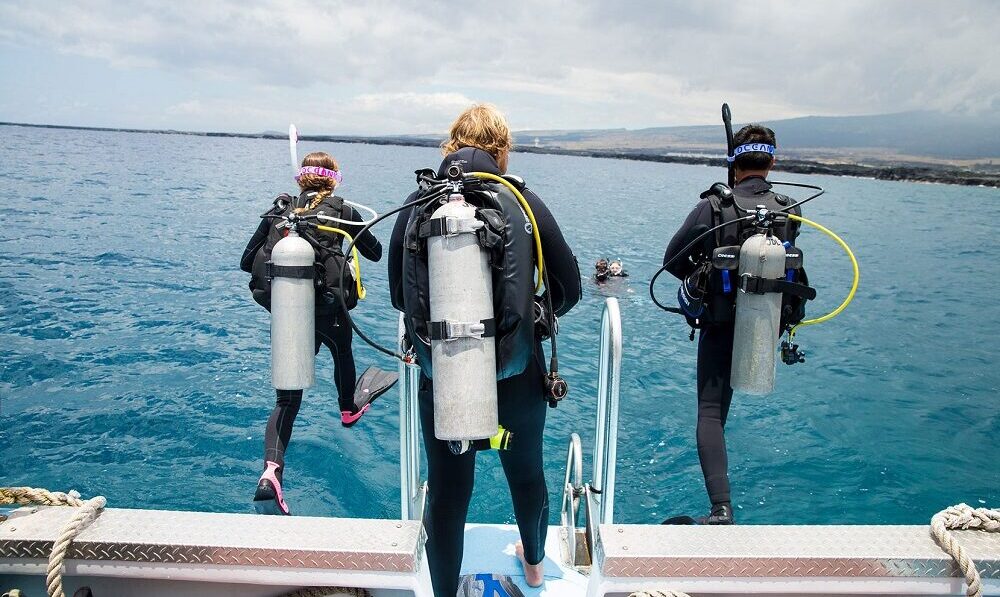
Open Water Practice
The PADI Open Water Diver course includes four open water dives which usually take place over at least two days. Each dive has been designed to give divers the opportunity to practice and hone their diving skills while increasing confidence and comfort in the water.
Each dive includes a number of instructor-assessed skills. Some skills need to be completed on a certain, specific dive, while other “dive-flexible skills” can be performed at any convenient time when you’re in or under the water.
Dive-Flexible Skills
During the four open water dives, you will be required to perform certain dive skills which will be assessed by your instructor.
These dive-flexible skills are assessed at the water’s surface and can be performed during dives 1, 2, 3 or 4:
- Cramp Removal Techniques on a Buddy and Yourself
- Tired Diver Tow (25 meters/yards)
- Straight Line Compass Swim (50 meters/yards)
- Snorkel/Regulator Exchange
- Remove and Replace Gear (Scuba Unit and Weight System)
- Inflatable Signal Tube Use (Can be done on the surface or, when using a Delayed Surface Marker Buoy (DSMB), underwater.)
- Emergency Weight Drop (If not already done on one of your confined water sessions)
These dive-flexible skills are assessed underwater and can be performed during dives 2, 3 or 4:
- Compass Navigation – Straight-Line Swim (Out and Back)
- Controlled Emergency Swimming Ascent (CESA)
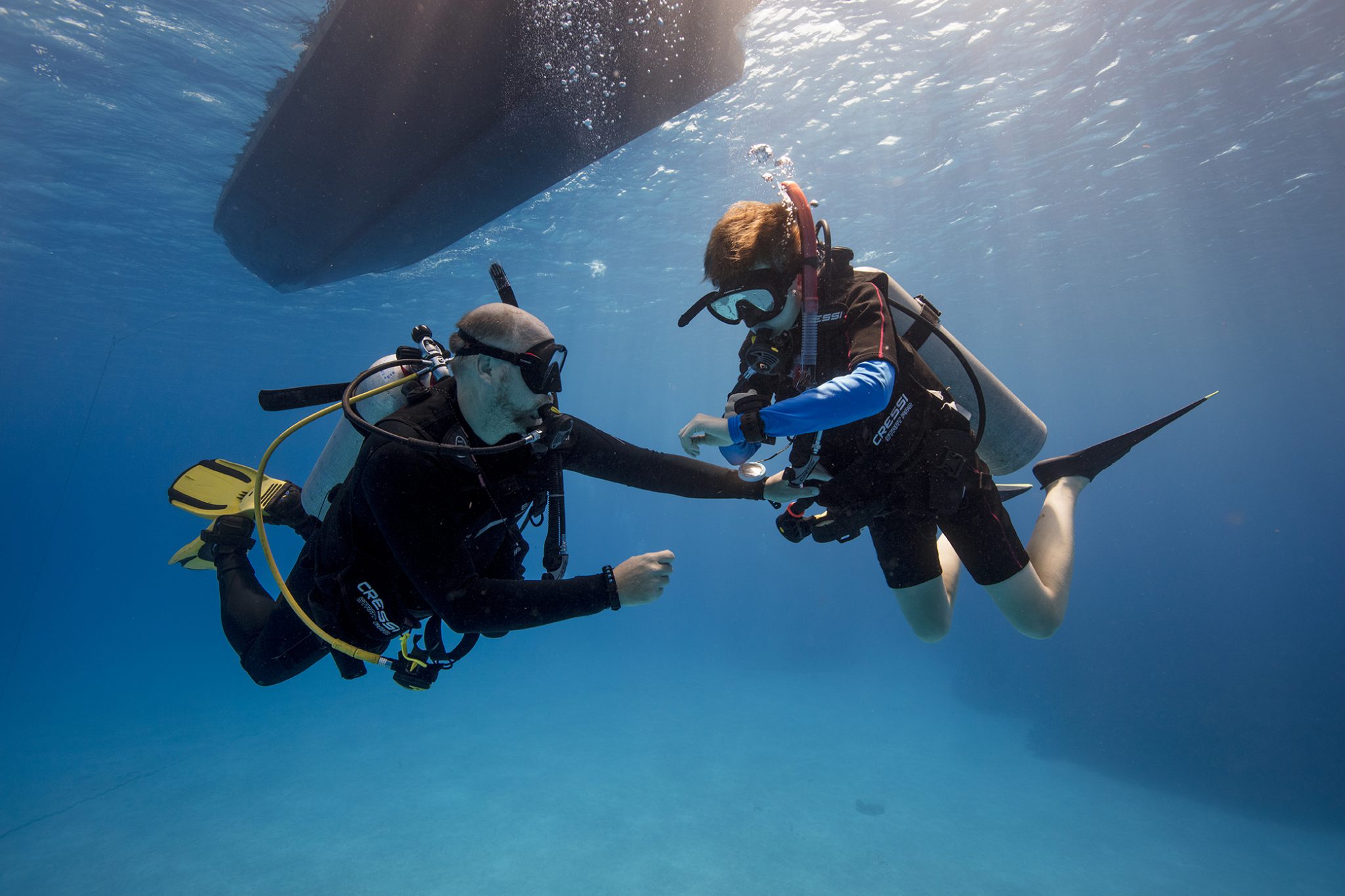
PADI Open Water Dives 1 and 2
PADI Open Water dives 1 and 2 are mainly about introducing new divers to open water and establishing in-water comfort. This is especially true for dive 1, before more advanced skills are introduced in dive 2. Each dive starts, as all future dives will, with assembling and putting on your scuba gear, performing a pre-dive safety check and assessing the weight you need to carry during the dive. It is also normal for time to be spent on correct techniques for entering and exiting the water, correcting buoyancy and equalizing.
The maximum depth for dives 1 and 2 is 12 meters/40 feet.
Open Water Dive 1:
As the first time divers are entering open water during the PADI Open Water course, this dive is often kept simple intentionally. Before entering the water, divers will:
- Put on scuba equipment
- Perform a pre-dive safety check
- Adjust weight (if necessary)
- Review hand signals
These steps will be present on all 4 open water dives.
Once in the water, you will perform a controlled descent, either using a descent line or by following a sloping bottom contour. After descending to a maximum of 12 meters/40 feet, you will complete a trim check, clear a partially flooded mask, and recover and clear your regulator as the underwater skills. You’ll also of course get a chance to explore the dive site with the instructor before ascending and finishing the dive.
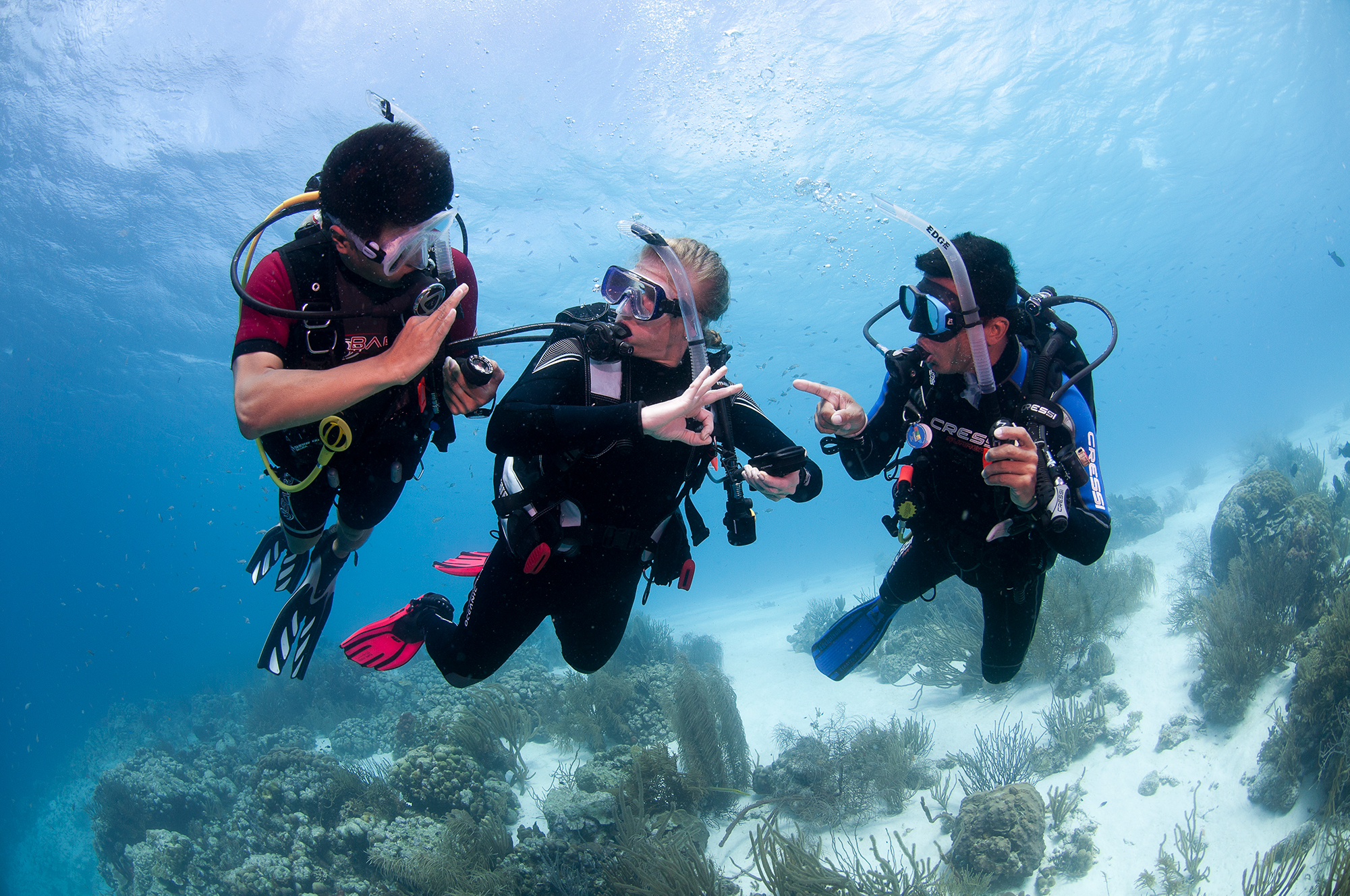
Open Water Dive 2:
Surface preparation for open water dive 2 is similar to dive 1. However, divers will now also have to plan the dive and establish correct buoyancy at the surface. The start of dive 2 looks like this:
- Use a dive computer or recreational dive planner (RDP) to plan the dive
- Put on your scuba equipment
- Perform a pre-dive safety check
- Adjust weight (if necessary)
- Orally inflate your BCD while at the surface
Once in the water, you will use the five-point method to descend to a maximum of 12 meters/40 feet again using a control line or the sloping bottom contour. Once at depth, you will need to make yourself neutrally buoyant using your low pressure inflator. Then, it’s time to demonstrate the following dive 2-specific skills:
After completion, any remaining time will be spent exploring the dive site, staying aware of your air consumption and your buddy’s location, before you use the five-point method to ascend to the surface while maintaining buddy contact and performing a safety stop along the way.
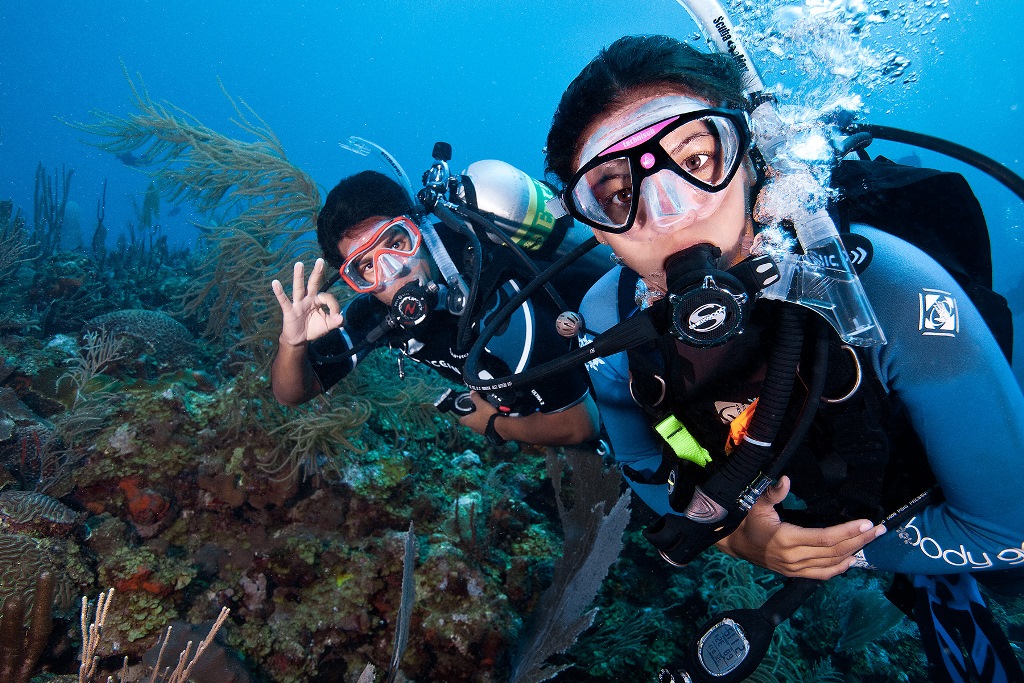
PADI Open Water Dives 3 and 4
An increase in the maximum depth and the addition of more surface and in-water skills make open water dives 3 and 4 the ideal progression to grow your in-water capabilities. The PADI Open Water dive 3 and 4 skills will complete what is required to become certified as a PADI Open Water Diver. It’s also likely that, during these dives, you will have more time to explore the underwater world to further build your confidence and diving competency.
The maximum depth for open water dives 3 and 4 is 18 meters/60 feet.
Open Water Dive 3:
By dive 3, the dive preparation steps should look somewhat familiar:
- Use a dive computer or recreational dive planner (RDP) to plan the dive
- Put on your scuba equipment
- Perform a pre-dive safety check
- Adjust weight (if necessary)
After descending to a maximum of 18 meters/60 feet using the five-point method (with only visual references to assist the descent), you will be required to perform these dive 3-specific skills:
- Inflate your BCD orally to become neutrally buoyant and hover
- Clear a fully flooded mask
Once complete, you will explore the dive site, staying aware of your air consumption and your buddy’s location, before using the five-point method to ascend while maintaining contact with your buddy, performing a safety stop on the way up.
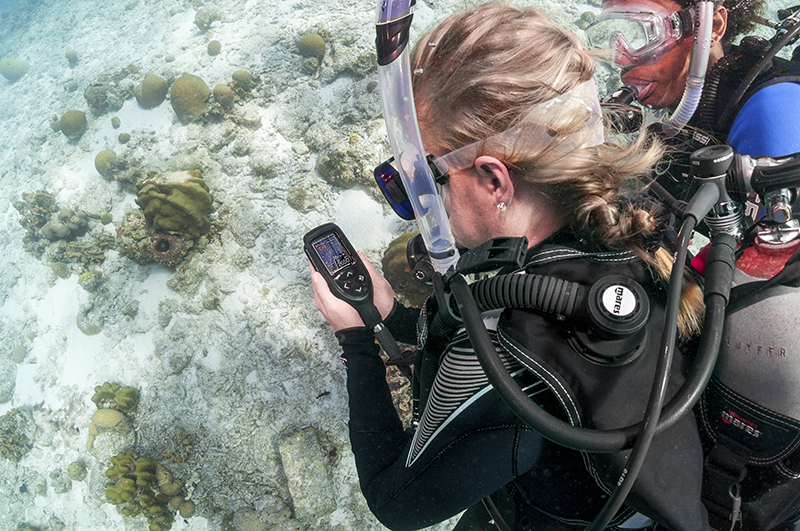
Open Water Dive 4:
PADI Open Water dive 4 skills are usually made up of any remaining dive-flexible skills which have not performed during the other 3 open water dives. By now, dive preparation and the entry procedure should be comfortably familiar:
- Use a dive computer or recreational dive planner (RDP) to plan the dive using the PADI Skill Practice and Dive Planning Slate
- Put on your scuba equipment
- Perform a pre-dive safety check
- Adjust weight (if necessary)
Divers will then descend using the five-point method and without a reference this time. Once at depth, you don’t have any formal skills to practice, so you can concentrate on exploring the dive site while still under the watchful eye of your Instructor before using the five-point method to ascend to the surface while maintaining contact with your buddy.
And that’s it! The four open water dives are complete! You will now have the underwater experience and have performed the required dive skills to become certified as a PADI Open Water Diver. Thousands of dive centers, dive resorts and liveaboards around the world await!
Have more questions? Check out our scuba certification FAQ page. Or, if you’re ready to jump in and learn to dive, sign up for your PADI Open Water Course today!

